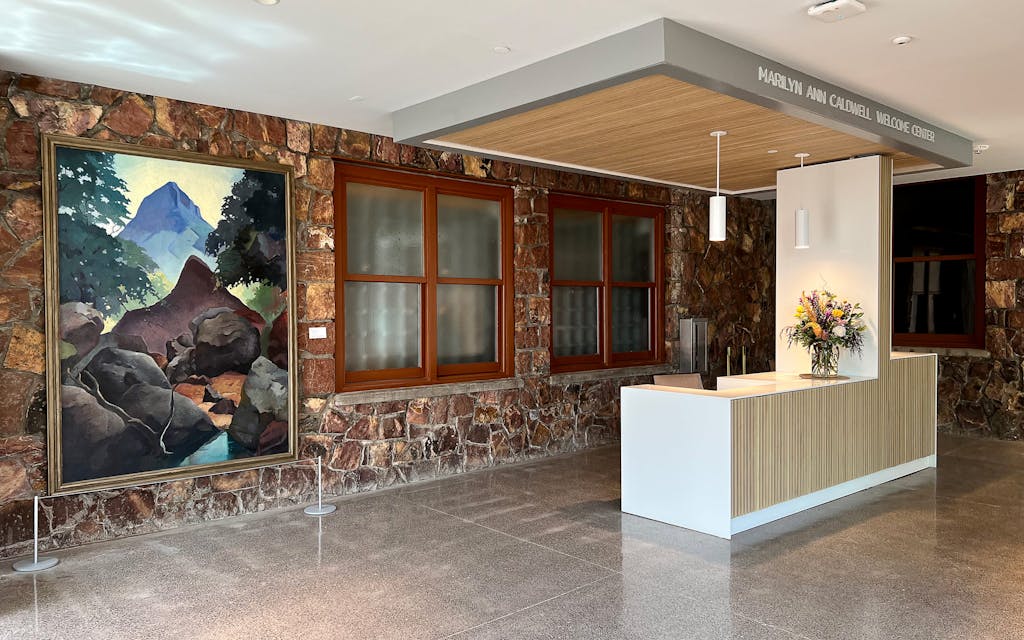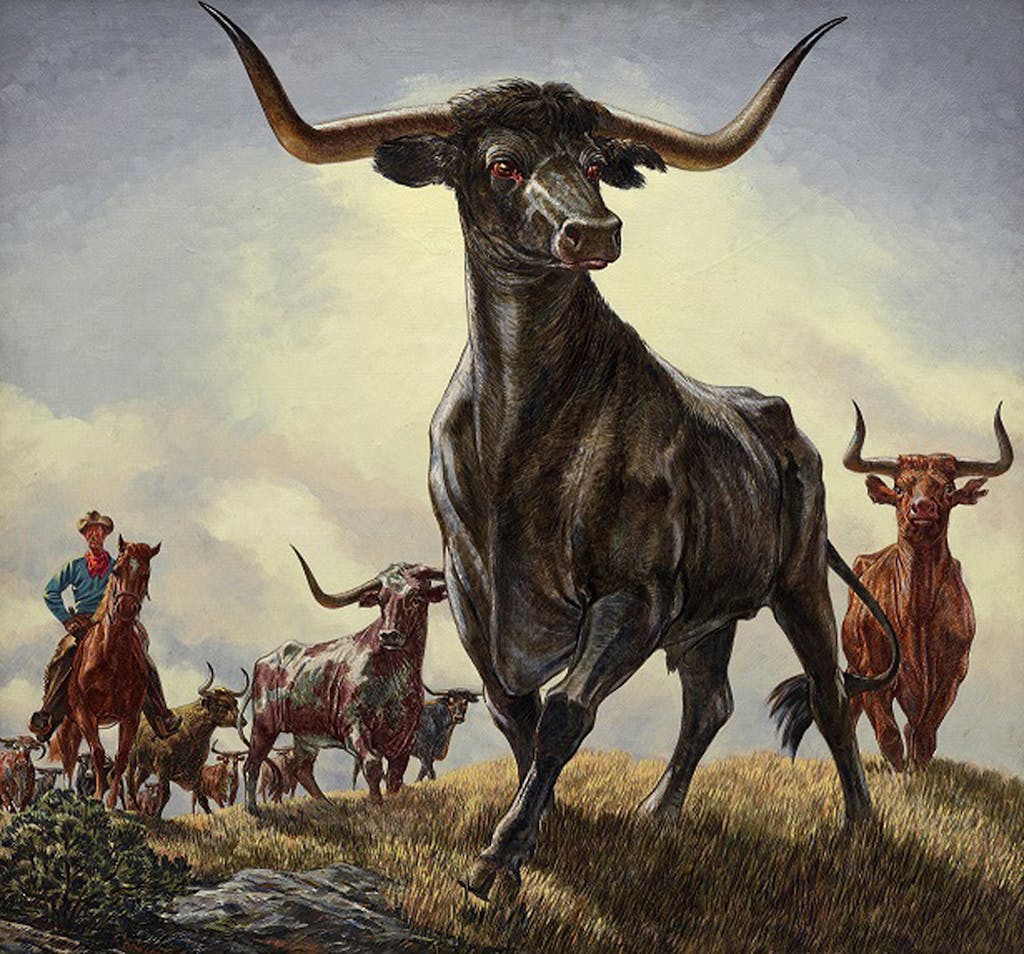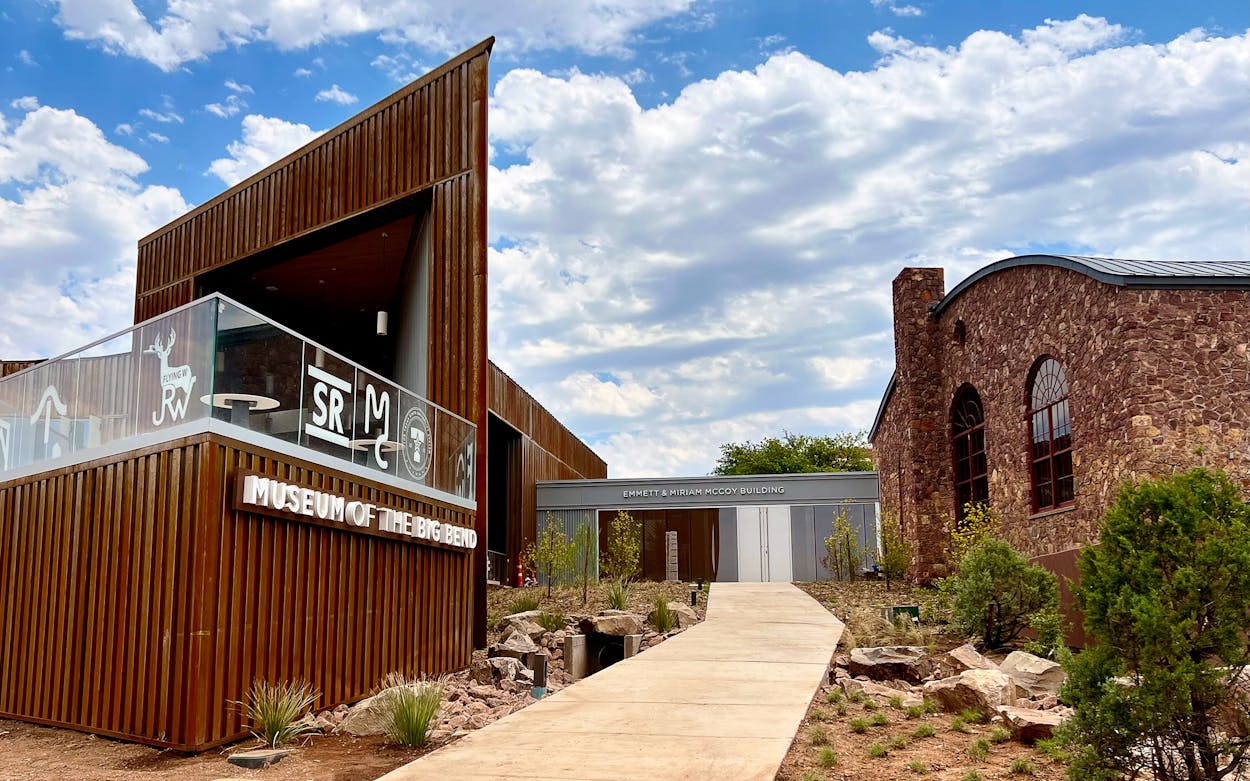Mitre Peak cuts a striking figure against the West Texas sky, its angular summit piercing the desert mountain landscape between Alpine and Fort Davis. Nearly a century ago, the landmark captured the imagination of San Antonio artist Julius Woeltz, who painted a large canvas of Mitre Peak looming above a colorful foreground of boulders, oak trees, and a glimmer of water.
Woeltz’s seven-by-five-foot work, created in the early 1930s, gives viewers an intimate look at the peak, as if they were approaching on foot and stopped to rest along a shady stream. For a broader perspective, however, you can step out onto the sunny porch of the painting’s home—the Museum of the Big Bend in Alpine—and see Mitre Peak itself about ten miles to the northwest, a jagged tooth against the vast Davis Mountains horizon.
Such is the case with many of the artworks featured in the Museum of the Big Bend’s new Emmett and Miriam McCoy Building, which celebrates its grand opening June 23 and 24. The 10,000-square-foot, $11 million expansion doubles the museum’s size and includes multiple galleries that showcase artworks interpreting the landscapes, cultures, and history of far West Texas.
“The museum is now able to tell not only the history of the Big Bend but also the story of the artists who came to this area to experience the vast landscape and big skies,” says Mary Bones, museum director. “You’re getting a fuller story of the people, the history, and the art of the area.”
Located on the campus of Sul Ross State University in Alpine, the Museum of the Big Bend has long chronicled regional heritage, particularly since the restoration of its 1937 native-stone home and the debut of new historical exhibits in 2007. The museum welcomes about 20,000 visitors annually, a fraction of the 500,000-plus who make the trek to Big Bend National Park, located about an hour to the south. But for those in the know, a stopover at the Alpine museum offers an illuminating look at the people who have shaped the region, from Indigenous inhabitants to explorers, soldiers, ranchers, miners, and the National Park Service. The new expansion amplifies an artistic viewpoint of its Chihuahuan Desert surroundings and elevates Sul Ross’s long, storied connection to the Texas art scene.
Today, when you think of West Texas and fine art, you probably think of Marfa. But in the 1930s, Alpine had a small but thriving visual arts scene centered around a workshop called the Summer Art Colony. In 1932, what was then known as Sul Ross Teachers College hired Woeltz to direct its art department. Working with his San Antonio friend and colleague Xavier Gonzalez, Woeltz launched a summer painting workshop with courses open to students and the public. Woeltz and Gonzalez left in 1936 and ’38, respectively, but they laid the groundwork for a series of high-profile Texas painters of the ’30s and ’40s, including Otis Dozier, William Lester, and Harry Anthony DeYoung, who all served as summer instructors. The workshops focused mostly on outdoor painting, known as en plein air. The classes traveled to practice their craft at places such as Santa Elena Canyon on the Rio Grande and the historic Fort Davis frontier military post.

“You had this opportunity to work with some of the best early Texas artists in the state,” Bones explains. “There was studio painting and classroom instruction, but they also did a lot of traveling in the area and exposed students to this beautiful country—the light, the sky, and the great topography and geology that you can’t really find in any other part of the state.”
The museum’s new building highlights four large artworks that came from the Summer Art Colony, including Woeltz’s Mitre Peak and Branding Scenic Cathedral Mountain. The latter depicts cowboys working with cattle on a ranch south of Alpine. In the same hallway, visitors will find two six-by-fourteen-foot paintings by Gonzalez. Moonlight over the Chisos, painted in 1934, depicts dramatic clouds in the Chisos Mountains of Big Bend National Park; his Davis Mountains conveys the landscape of Davis Mountains State Park and shows the first McDonald Observatory dome completed on Mount Locke in 1939.
A highlight of the new exhibit is Tom Lea’s eleven-painting series, dubbed “Western Beef Cattle.” Following World War II, the intrepid El Paso artist spent a year traveling and documenting the North American cattle industry for Life magazine. The paintings—on long-term loan from the Dallas Museum of Art—chronicle the history of cattle in the New World. Lea imagined the livestock across time and territory, from Spanish conquistadors unloading cows from a ship at Vera Cruz, Mexico; to wild-eyed Texas longhorns on the range; to the goings-on of the Chicago stockyards.
“There’s a real heritage as far as artists who’ve gone out to the Trans-Pecos and done work there,” says Ron Tyler, a board member of the Center for the Advancement and Study of Early Texas Art and past director of the Amon Carter Museum of American Art in Fort Worth. “But at the same time, the Big Bend doesn’t really fit the definition of regional because it’s such a spectacular place and has drawn artists from many different countries.”
Fred Darge straddles the line of regional and international artists in the Museum of the Big Bend’s new galleries. Born in Germany in 1900, Darge immigrated to Chicago in 1923, attended art school, and ended up in Dallas in 1935. He made extended painting excursions to the Big Bend over the following decades, capturing scenes of ranching life, goat herders, and sheep shearing.

“I have seen some exceptionally good paintings by Darge,” says J.P. Bryan, a well-known collector of Western art and artifacts who founded the Bryan Museum in Galveston and serves as executive director of the Texas State Historical Association. “He captured our culture at an important time just like Tom Lea did, and so did José Cisneros.” Two Cisneros watercolor paintings—among thirty-plus artworks on loan from the John L. Nau III Collection of Texas Art—are part of the Museum of the Big Bend’s opening exhibit. “Those guys gave us a real gift in terms of translating the past to the present.”
The historical theme links the new art galleries to the Museum of the Big Bend’s original building, which holds a collection of historical maps and the sweeping “Big Bend Legacy” gallery. “There probably won’t be another museum that will have the art and artifacts and other things to express any better the history of what happened in the Trans-Pecos region of Texas than they have,” said Bryan, who also owns the Gage Hotel in Marathon. He’s in the midst of a project with local officials to renovate the vintage Marathon Museum, near the Gage, with art and artifacts from the Bryan Museum’s collection. “I think both what the Big Bend museum seems inclined to do, and what we’re getting ready to do in Marathon, is to tell a story to help people know a whole lot more about the place they’re visiting and hopefully inspire them to want to come back.”

The Museum of the Big Bend broke ground on the $11 million expansion in August 2021, following a four-year fundraising effort. It’s the latest chapter for an institution that started with the collection of a single arrowhead from nearby Sunny Glen in 1921.
The new building got its name based on a $5 million gift from Miriam McCoy, the late widow of Emmett McCoy. Emmett McCoy was a San Marcos–based entrepreneur who grew his father’s roofing company into McCoy’s Building Supply, one of the nation’s largest family-owned vendors of construction materials.
From above, the new building looks something like a triangular wing attached to the museum’s historic native-stone home, which was built in 1937 with funding from the Texas Centennial Commission. Rather than trying to match the historical stone, Bones said, designers chose a treated corten steel exterior. The siding is weathering into a reddish-brown that offsets the deeper burgundy of the native stone.
Designed by Larry Speck of Page Architects in Austin, the new building contains other nods to its older sibling. Half-moon window bays harken to the curvature of the 1937 building’s exposed lamella arch roof. And in the museum’s new entryway, where the two buildings converge, the old stone exterior meets the floor-to-ceiling windows and woodwork of the new building.
Even the new flooring is deliberate—the polished concrete contains local aggregate to imbue it with the grays and reds of the surrounding volcanic mountains. “We kept it a very simple design and used simple materials so we could ease the pressure of maintenance for the building,” Bones says.
The windows and patio are perhaps the building’s most striking features, because they capture the West Texas light and open to vistas of the Davis Mountains. Perched on the side of Hancock Hill (not far from its beloved desk), the location looks across Alpine to the ranges beyond. The landscaping around the building also leans on the natural surroundings, utilizing boulders and native plants including ocotillo, palo verde trees, and basket grass.
There’s also a new event space that the museum plans to rent for parties, workshops, and the like. “The idea was not only would we have gallery space and collection storage, but we’d also have a cultural event center, which could become a revenue source to support the museum,” Bones says. “The event center will give us more programming opportunities for the community and visitors.”
Now that Bones has shepherded the Emmett and Miriam McCoy Building to fruition, she’s setting her sights on upgrading the museum’s original building with a $750,000 matching grant from the National Endowment for the Humanities. The project includes the creation of a Texas Map Research Center, upgrades to the museum’s education center and utilities, and a refresh of the “Big Bend Legacy” permanent exhibit.
Tyler hopes the Museum of the Big Bend’s growth will enable it to entice more people as Big Bend National Park continues to see surging attendance. “This may very well lift the museum to another level and attract a larger public,” he says. “There’s enormous potential because the national park continues to be an attraction, and that’s only growing. The museum has been a part of that equation and will become an even more important part of it now.”






